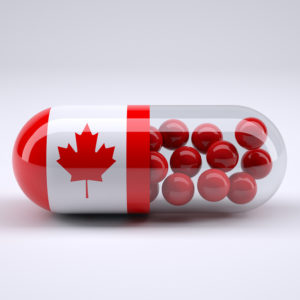The Senate hosted yet another hearing earlier this month on prescription drug pricing. But state legislators are getting tired of waiting for federal action to address their residents’ prescription drug costs. So far this year 16 states have introduced 27 bills to allow prescription drug imports from Canada.
Importing prescription drugs from Canada enjoys popular support. A Kaiser poll last month found that four-fifths of respondents support importing drugs from Canada. A 2016 survey of American adults found that 8 percent of respondents said they or someone in their household had imported prescription drugs.
But as a matter of broad public policy, wholesale importation is not a solution to lowering drug costs. Canada’s population of 37 million isn’t much bigger than the combined size of Florida and Illinois, the two largest states currently pursuing importation legislation. The Canadian drug supply is nowhere near the scale that would be necessary to provide drugs to the massive American market.
According to a study published last year in Health Economics, if just 20 percent of U.S. prescriptions were filled using Canadian prescription drug sources, the Canadian drug supply would run out in 183 days. Since generic drugs are about twice as expensive in Canada as in the United States, imports would likely be limited to brand name drugs. Proposed bills like Oregon’s HB 2689 say imports would have to “generate substantial savings for consumers.” In that case, Canada’s brand name drug supply would still be exhausted in 201 days.
Like the United States, Canada is experiencing drug shortages. According to Canada’s C.D. Howe Institute, approximately 1,000 shortages have been reported annually, affecting at least 10 percent of all active drugs in the country. Exporting Canada’s limited supply to the United States would generate a significant public backlash. Drugs that could somehow be exported would almost surely command a significantly higher price in the United States than in Canada, reducing the arbitrage opportunity and foreseeably driving up Canada’s own prices, as has been demonstrated by similar lateral trade schemes in Europe and China.
Recognizing these supply constraints, Canada announced in 2005 that it would ban wholesale drug exports to the United States. As the Canadian health minister pointed out at the time, “Canada cannot be the drugstore for the United States.”
Wholesale prescription drug importation from Canada is not just impractical. There’s also a significant question of safety, especially as news of state-sanctioned import programs could lead U.S. consumers to trust other “Canadian” sources for prescriptions.
Countless American patients have learned the hard way that “Canadian” online pharmacies are often not Canadian. In recent years, thousands of patients across the country have been exposed to counterfeit drugs. Some have suffered serious injury, and some have died, as a result.
An FDA operation in 2005 suggested that just 15 percent of purportedly Canadian online prescription drug purchases originate in Canada; the rest of these drugs come from distant countries, including China and Turkey. Health Canada has acknowledged it cannot guarantee the safety of drugs purchased on these online platforms that advertise themselves as “Canadian.”
Websites with names like Canada Drugs and CanaRx have been singled out by the FDA for their role in selling counterfeit drugs. In a statement last month, outgoing FDA Commissioner Scott Gottlieb warned, “Operations like CanaRx use their names to imply that patients are receiving medicines approved in Canada, when it’s likely that patients are receiving medicines from other countries, and which may be sub-potent, super-potent or counterfeit.”
The inability to guarantee the safety of drug imports is why the past four FDA administrators, serving under both Republican and Democratic administrations, have opposed drug importation. “There is no effective way,” says Gottlieb, “to ensure drugs coming from Canada really are coming from Canada, rather than being routed from, say, a counterfeit factory in China.”
With the World Health Organization now estimating that one in 10 drugs from less developed countries are counterfeit, Americans seeking to lower their drug costs must recognize the risks of import shortcuts.
Just as important as identifying the right policy solutions to the country’s prescription drug cost problem is exposing distracting or counterproductive proposals. Drug importation legislation, while well-intentioned, is the wrong prescription to lower national drug costs.

